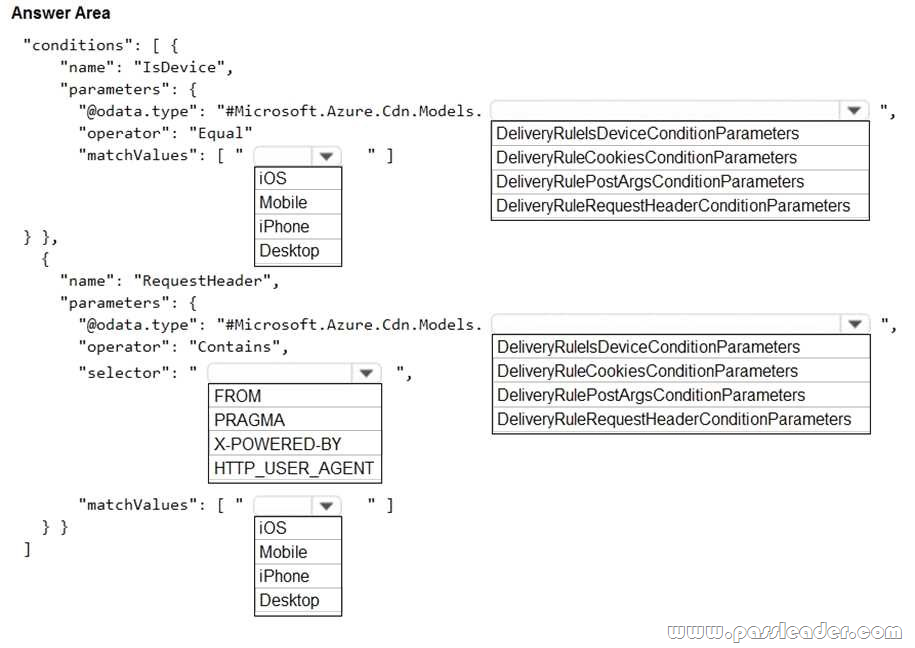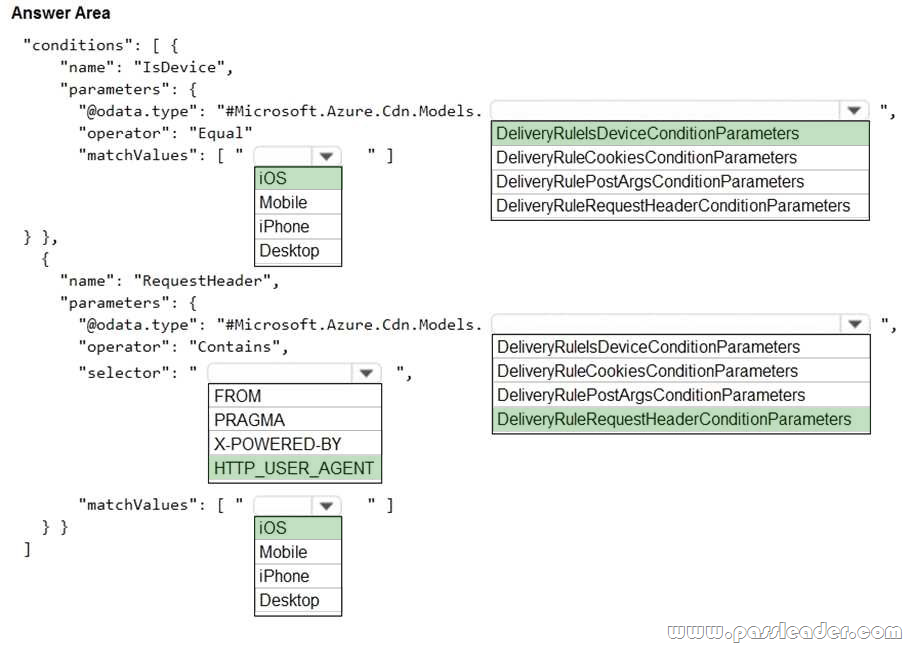Valid AZ-204 Dumps shared by PassLeader for Helping Passing AZ-204 Exam! PassLeader now offer the newest AZ-204 VCE dumps and AZ-204 PDF dumps, the PassLeader AZ-204 exam questions have been updated and ANSWERS have been corrected, get the newest PassLeader AZ-204 dumps with VCE and PDF here: https://www.passleader.com/az-204.html (349 Q&As Dumps –> 377 Q&As Dumps –> 427 Q&As Dumps –> 452 Q&As Dumps –> 498 Q&As Dumps –> 519 Q&As Dumps –> 552 Q&As Dumps –> 634 Q&As Dumps)
BTW, DOWNLOAD part of PassLeader AZ-204 dumps from Cloud Storage: https://drive.google.com/open?id=1_dGx5coDJPG4zq5xvUhc2LmfQ-jO_xyp
NEW QUESTION 336
You develop and deploy an Azure App Service API app to a Windows-hosted deployment slot named Development. You create additional deployment slots named Testing and Production. You enable auto swap on the Production deployment slot. You need to ensure that scripts run and resources are available before a swap operation occurs.
Solution: Update the app with a method named statuscheck to run the scripts. Update the app settings for the app. Set the WEBSITE_SWAP_WARMUP_PING_PATH and WEBSITE_SWAP_WARMUP_PING_STATUSES with a path to the new method and appropriate response codes.
Does the solution meet the goal?
A. Yes
B. No
Answer: B
Explanation:
Instead update the web.config file to include the applicationInitialization configuration element. Specify custom initialization actions to run the scripts.
https://docs.microsoft.com/en-us/azure/app-service/deploy-staging-slots#troubleshoot-swaps
NEW QUESTION 337
You are developing a website that will run as an Azure Web App. Users will authenticate by using their Azure Active Directory (Azure AD) credentials. You plan to assign users one of the following permission levels for the website: admin, normal, and reader. A user’s Azure AD group membership must be used to determine the permission level. You need to configure authorization.
Solution: Configure and use Integrated Windows Authentication in the website. In the website, query Microsoft Graph API to load the group to which the user is a member.
Does the solution meet the goal?
A. Yes
B. No
Answer: B
Explanation:
Microsoft Graph is a RESTful web API that enables you to access Microsoft Cloud service resources. Instead in the Azure AD application’s manifest, set value of the groupMembershipClaims option to All. In the website, use the value of the groups claim from the JWT for the user to determine permissions.
https://blogs.msdn.microsoft.com/waws/2017/03/13/azure-app-service-authentication-aad-groups/
NEW QUESTION 338
You are developing a web application that runs as an Azure Web App. The web application stores data in Azure SQL Database and stores files in an Azure Storage account. The web application makes HTTP requests to external services as part of normal operations. The web application is instrumented with Application Insights. The external services are OpenTelemetry compliant. You need to ensure that the customer ID of the signed in user is associated with all operations throughout the overall system. What should you do?
A. Create a new SpanContext with the TraceRags value set to the customer ID for the signed in user.
B. On the current SpanContext, set the Traceld to the customer ID for the signed in user.
C. Add the customer ID for the signed in user to the CorrelationContext in the web application.
D. Set the header Ocp-Apim-Trace to the customer ID for the signed in user.
Answer: D
NEW QUESTION 339
You develop and deploy an Azure Logic app thai calls an Azure Function app. The Azure Function app includes an OpenAPl (Swagger) definition and uses an Azure Blob storage account. All resources are secured by using Azure Active Directory (Azure AD). The Azure Logic app must securely access the Azure Blob storage account. Azure AD resources must remain if the Azure Logic app is deleted. You need to secure the Azure Logic app. What should you do?
A. Create an Azure AD custom role and assign role-based access controls.
B. Create an Azure AD custom role and assign the role to the Azure Blob storage account.
C. Create an Azure Key Vault and issue a client certificate.
D. Create a user-assigned managed identity and assign role-based access controls.
E. Create a system-assigned managed identity and issue a client certificate.
Answer: C
NEW QUESTION 340
You develop Azure solutions. A .NET application needs to receive a message each time an Azure virtual machine finishes processing data. The messages must NOT persist after being processed by the receiving application. You need to implement the .NET object that will receive the messages. Which object should you use?
A. QueueClient
B. SubscriptionClient
C. TopicClient
D. CloudQueueClient
Answer: D
Explanation:
A queue allows processing of a message by a single consumer. Need a CloudQueueClient to access the Azure VM.
Incorrect:
Not B and C: In contrast to queues, topics and subscriptions provide a one-to-many form of communication in a publish and subscribe pattern. It’s useful for scaling to large numbers of recipients.
https://docs.microsoft.com/en-us/azure/service-bus-messaging/service-bus-queues-topics-subscriptions
NEW QUESTION 341
You are preparing to deploy a website to an Azure Web App from a GitHub repository. The website includes static content generated by a script. You plan to use the Azure Web App continuous deployment feature. You need to run the static generation script before the website starts serving traffic. What are two possible ways to achieve this goal? (Each correct answer presents a complete solution. Choose two.)
A. Add the path to the static content generation tool to WEBSITE_RUN_FROM_PACKAGE setting in the host.json file.
B. Add a PreBuild target in the websites csproj project file that runs the static content generation script.
C. Create a file named run.cmd in the folder /run that calls a script which generates the static content and deploys the website.
D. Create a file named .deployment in the root of the repository that calls a script which generates the static content and deploys the website.
Answer: AD
Explanation:
A: In Azure, you can run your functions directly from a deployment package file in your function app. The other option is to deploy your files in the d:\home\site\wwwroot directory of your function app (see A above). To enable your function app to run from a package, you just add a WEBSITE_RUN_FROM_PACKAGE setting to your function app settings.
D: To customize your deployment, include a .deployment file in the repository root.
https://github.com/projectkudu/kudu/wiki/Custom-Deployment-Script
https://docs.microsoft.com/bs-latn-ba/azure/azure-functions/run-functions-from-deployment-package
NEW QUESTION 342
You are developing a mobile instant messaging app for a company. The mobile app must meet the following requirements:
– Support offline data sync.
– Update the latest messages during normal sync cycles.
You need to implement Offline Data Sync. Which two actions should you perform? (Each correct answer presents part of the solution. Choose two.)
A. Retrieve records from Offline Data Sync on every call to the PullAsync method.
B. Retrieve records from Offline Data Sync using an Incremental Sync.
C. Push records to Offline Data Sync using an Incremental Sync.
D. Return the updatedAt column from the Mobile Service Backend and implement sorting by using the column.
E. Return the updatedAt column from the Mobile Service Backend and implement sorting by the message id.
Answer: BE
Explanation:
B: Incremental Sync: the first parameter to the pull operation is a query name that is used only on the client. If you use a non-null query name, the Azure Mobile SDK performs an incremental sync. Each time a pull operation returns a set of results, the latest updatedAt timestamp from that result set is stored in the SDK local system tables. Subsequent pull operations retrieve only records after that timestamp.
E (not D): To use incremental sync, your server must return meaningful updatedAt values and must also support sorting by this field. However, since the SDK adds its own sort on the updatedAt field, you cannot use a pull query that has its own orderBy clause.
https://docs.microsoft.com/en-us/azure/app-service-mobile/app-service-mobile-offline-data-sync
NEW QUESTION 343
You are developing an Azure function that connects to an Azure SQL Database instance. The function is triggered by an Azure Storage queue. You receive reports of numerous System.InvalidOperationExceptions with the following message:
“Timeout expired. The timeout period elapsed prior to obtaining a connection from the pool. This may have occurred because all pooled connections were in use and max pool size was reached.”
You need to prevent the exception. What should you do?
A. In the host.json file, decrease the value of the batchSize option.
B. Convert the trigger to Azure Event Hub.
C. Convert the Azure Function to the Premium plan.
D. In the function.json file, change the value of the type option to queueScaling.
Answer: C
Explanation:
With the Premium plan the max outbound connections per instance is unbounded compared to the 600 active (1200 total) in a Consumption plan.
https://docs.microsoft.com/en-us/azure/azure-functions/manage-connections
https://docs.microsoft.com/en-us/azure/azure-functions/functions-scale#service-limits
NEW QUESTION 344
You develop a solution that uses Azure Virtual Machines (VMs). The VMs contain code that must access resources in an Azure resource group. You grant the VM access to the resource group in Resource Manager. You need to obtain an access token that uses the VMs system-assigned managed identity. Which two actions should you perform? (Each correct answer presents part of the solution. Choose two.)
A. Use PowerShell on a remote machine to make a request to the local managed identity for Azure resources endpoint.
B. Use PowerShell on the VM to make a request to the local managed identity for Azure resources endpoint.
C. From the code on the VM. call Azure Resource Manager using an access token.
D. From the code on the VM. call Azure Resource Manager using a SAS token.
E. From the code on the VM. generate a user delegation SAS token.
Answer: BC
NEW QUESTION 345
You have an existing Azure storage account that stores large volumes of data across multiple containers. You need to copy all data from the existing storage account to a new storage account. The copy process must meet the following requirements:
– Automate data movement.
– Minimize user input required to perform the operation.
– Ensure that the data movement process is recoverable.
What should you use?
A. AzCopy
B. Azure Storage Explorer
C. Azure Portal
D. .NET Storage Client Library
Answer: A
Explanation:
You can copy blobs, directories, and containers between storage accounts by using the AzCopy v10 command-line utility. The copy operation is synchronous so when the command returns, that indicates that all files have been copied.
https://docs.microsoft.com/en-us/azure/storage/common/storage-use-azcopy-blobs-copy
NEW QUESTION 346
Hotspot
You are building a website that is used to review restaurants. The website will use an Azure CDN to improve performance and add functionality to requests. You build and deploy a mobile app for Apple iPhones. Whenever a user accesses the website from an iPhone, the user must be redirected to the app store. You need to implement an Azure CDN rule that ensures that iPhone users are redirected to the app store. How should you complete the Azure Resource Manager template? (To answer, select the appropriate options in the answer area.)

Answer:

Explanation:
https://docs.microsoft.com/en-us/azure/active-directory/conditional-access/concept-conditional-access-conditions
https://docs.microsoft.com/en-us/azure/active-directory/conditional-access/concept-conditional-access-grant
NEW QUESTION 347
Drag and Drop
You are developing a REST web service. Customers will access the service by using an Azure API Management instance. The web service does not correctly handle conflicts. Instead of returning an HTTP status code of 409, the service returns a status code of 500. The body of the status message contains only the word conflict. You need to ensure that conflicts produce the correct response. How should you complete the policy? (To answer, drag the appropriate code segments to the correct locations. Each code segment may be used once, more than once, or not at all. You may need to drag the split bar between panes or scroll to view content.)

Answer:

Explanation:
https://docs.microsoft.com/en-us/azure/api-management/api-management-error-handling-policies
https://docs.microsoft.com/en-us/azure/api-management/api-management-transformation-policies
NEW QUESTION 348
……
Get the newest PassLeader AZ-204 VCE dumps here: https://www.passleader.com/az-204.html (349 Q&As Dumps –> 377 Q&As Dumps –> 427 Q&As Dumps –> 452 Q&As Dumps –> 498 Q&As Dumps –> 519 Q&As Dumps –> 552 Q&As Dumps –> 634 Q&As Dumps)
And, DOWNLOAD the newest PassLeader AZ-204 PDF dumps from Cloud Storage for free: https://drive.google.com/open?id=1_dGx5coDJPG4zq5xvUhc2LmfQ-jO_xyp